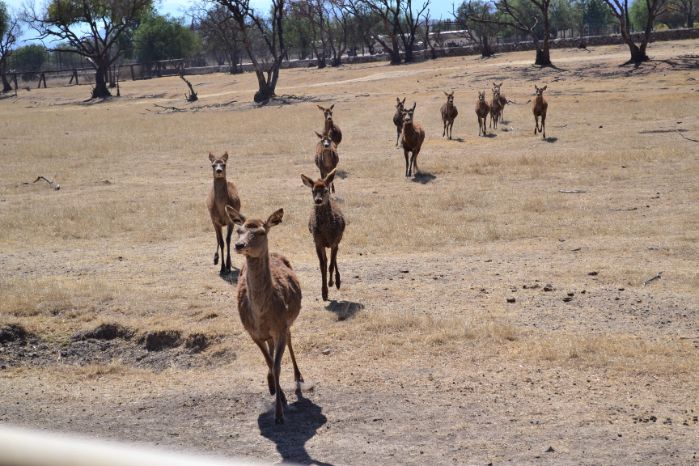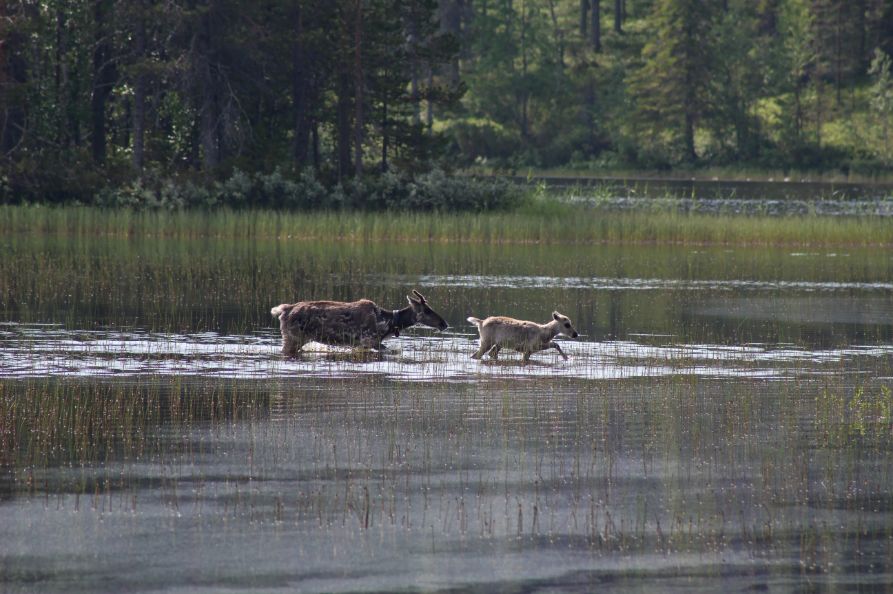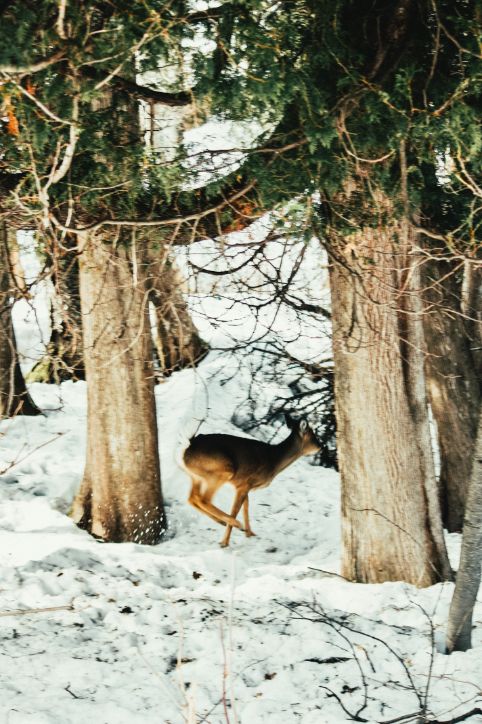The speed of the deer you are hunting cannot be predicted because it entirely depends on the deer and the circumstances. The fastest deer to run on record reached a top speed of around 30 mph. Deer can sprint fairly quickly, despite not being the fastest land animal. According to research, the mule deer may be the fastest deer in North America. Their speed varies slightly depending on the species.
Learn more about how quickly deer can run by reading this article.
Are Deer Fast Runners?
In North America, there are many different species of deer, each of which has its own unique habitat and daily ecological pressures. They may have evolved to run at a variety of speeds due to their various environmental contexts.
Additionally, the reason for their running will affect the speed at which they run. For instance, a deer is likely to run much faster when a predator is after it, but during mating season, high testosterone levels may also cause a buck to sprint after female deer.
However, a single deer or a herd of deer is likely to move at a much more leisurely pace when passing through a desert or woodland. A deer is also much less likely to run at such high speeds in the winter. Given the limited supply of food at the moment, the energy costs would be excessive.
In general, you can catch most deer running at an average speed of 35-40 miles per hour (55-65 km/h). Experts list this as the possible speed for most of the deer population. As a result, almost all deer can run this quickly, though they might not do so frequently or at all. This indicates that natural selection has largely contributed to this ability.
Here are three examples of deer running speeds by species to give you an idea of the varied physical characteristics of deer. You may be interested in Where Do Deer Sleep, Why Do Deer Shed Their Antlers And When?
White-tailed Deer, Odocoileus Virginianus
The white-tailed deer (also known as “whitetail deer”) is a species more common to the eastern half of the The western and southwestern parts of the United States are excluded from their habitat range, which stretches from southern Canada all the way down to Panama.
The average whitetail deer stands 3 feet 6 inches tall at the shoulder and weighs between 203 and 405 pounds for males and between 155-218 pounds for females.
But when they feel it necessary, they can move themselves quickly across the land, tsraveling at up to 35 mph (56 kph). Normally, though, these animals also move in the following gait patterns:
- Walking
- Trotting
- Bounding
Additionally, if you’re fortunate, you might see a deer swimming! In the summer, they might wade into the water in search of delectable plant matter.
But there are a few things that could frighten this deer into a quick sprint when it comes to running. You are one of them!
In the eyes of herbivorous animals like deer, humans are a predatory species, so if you walk into a place and surprise these ungulates (hooved mammals), you’ll give it quite the spook and send it fleeing into the vegetation.
Mule Deer, Odocoileus Hemonius

What the white-tailed deer is to the East, the mule deer is to the western United States. They inhabit the majority of the United States as well as a sizeable portion of North America overall, with their most northern habitats reaching the southern Yukon territory. Mid-Mexico is the southernmost point the mule deer might venture.
They grow to a height of about 3 feet, making them slightly smaller than their white-tailed cousins. They range in weight from 154 to 331 lbs, with a slightly heavier average. One might be tempted to believe that because they are heavier, they move more slowly when running. However, Theodore Garland Jr. had them pegged at nearly 38 miles per hour (70 km/h).
This is one of my favorite types of deer because it reminds me of off-road excursions I’ve had in western national and regional parks. As I said earlier, it’s interesting to think about the deer’s body size when imagining how fast they run. They manage to shift into high gear at a moment’s notice despite being quite heavy and bulky.
Past research has explored this topic, specifically the intrigue behind the fact that “the largest mammals are not the fastest.” Therefore, an ideal body size must exist in order to achieve the best speed for their needs, whether it be for migration, escape, or anything in between.
Interestingly, scientists report that an animal’s maximum running speeds are independent of its mass, as long as it’s within one of these three families:
- Artiodactyla: Also known as the “cloven-hooved” or even-toed ungulates, this family of mammals is home to domestic livestock like sheep and goats, as well as wild animals like antelope and deer, among many others.
- Carnivora: As implied by the name, this category includes terrifying carnivorous animal species.
- Rodentia: The term “rodent” is also used to describe this group. This is the proper place for every tiny gerbil, mouse, hamster, and other animal.
The mule deer can therefore move fairly quickly despite its size. The following time you go in search of one of these guys, keep that in mind.
Red Deer, Cervus Elaphus
One of the most fascinating aspects of the study into the physiology of the red deer at various speeds is that it was initially observed on a treadmill.
Three male deer weighing between 139 and 152 and 161 pounds were tested for movement on slopes between 7 and 14 degrees to measure their changing oxygen consumption.
So, even though they weren’t specifically interested in the animal’s top running speeds, they still provided the hunting and scientific communities with a useful understanding of what this deer is capable of.
At speeds ranging from 44.3 meters per minute to 172.9 meters per minute, the scientists tested the deer. (Both 1.68 mph and 6 mph can be calculated from this.)
The male red deer appeared to be uncomfortable maintaining a normal walking pace at that speed, so they began galloping at a speed of about 120 m per minute, or about 4.5 miles per hour.
Sadly, it appears that there is no information on the red deer’s fastest running speeds. The fact that they can gallop quickly is still useful if you’re chasing one down while on a hunt.
If you’re unsure of the red deer’s exact top speed, it’s safe to assume that it will be between 35 and 40 mph. These deer are primarily found in Kentucky, Texas, and California in North America. Additionally, they can be found all over Mexico and Canada.
How Far Can A Deer Run?
Deer can occasionally travel up to 40 miles per hour, making them quite quick animals. They are not only excellent swimmers but also swift in the water, with top speeds of up to 13 mph. Long strides allow whitetails to jump up to 25 feet because of their ability to do so. You can check out more information we have on Do Deer Move In The Rain?
Do Horses Run Faster Than A Deer?
If you have ever been to a racetrack, you have probably seen how quickly horses move. Due to their speed and agility, they resemble animals moving on wheels and engines. Except for a select few, very few animals can compete with horses. Sadly, a deer is not one of them, so a horse is quicker than a deer. Although the two types of animals can use speed in different ways, deer are much more swift but not as fast.
Tips On Hunting Running Deer

You are now fully informed about all the important details regarding deer. But after that, you ought to ask different questions. It’s true that shooting deer that are running can be difficult, but it’s not impossible. It goes without saying that you cannot catch a deer running after it.
However, there are various things you can do to make your hunting much more manageable. Considering that you will be an authority on this subject. To make a precise and more organic shot, follow these steps.
Do Not Use Soap For Bathing When You Go Hunting
The results of numerous studies indicate that human odor is a complex mixture. Our bodies and skin make up this complicated mixture. A deer can smell you from half a mile away, so it will find you very quickly. White-tailed species have been found to be senile odor receptors in studies.
They are capable of recognizing up to six different scents. It is therefore best to avoid wearing any kind of perfume while out and about. Some sprays remove any odor from your skin. Just get one for you!
A Deer Does Not Listen Like We Do: Be Silent Or Noisy
Compared to people, deer are not better listeners. Research has demonstrated it. Deer pay attention to sounds that we can hear. They do, however, have extremely high frequency hearing and hearing.
Their ears perform the role of satellite dishes. To categorize the sounds they hear, they lean forward and backward. You must therefore choose between remaining silent and speaking aloud.
Buy The Best Camouflages
Scientists assert that they actually saw a deer. In the range of 250 and 270 degrees. This range of views aids in the visualization of movement below the horizon. So you can overcome your vision if you purchase the best camouflages. Warm, natural colors help you blend in so deer won’t notice you’re there.
Practice Your Positions
Knowing yourself and your ideal position will help you aim correctly. When you have the opponent in your sights, it will be much simpler to shoot if you practice your position. Ensure that the rifles you purchase have targets.
Aim For The Deer Head
The deer’s head will take a lethal bullet. To ensure that the shot falls on the shoulders of the deer, aim for the back of the animal’s head. Never fire a side shot.
Conclusion
Deer are surprisingly swift animals, often reaching speeds of 35 to 40 mph (56 to 64 km/h) when they really get going. A horse or dog can outrun one, but you won’t be able to.
If deer hunting is new to you, you should spend some time learning how to control your movements in the woods. Additionally, you must practice shooting frequently, especially at moving targets. While it’s important to shoot at moving targets, it’s equally important to be familiar with deer behavior so you can anticipate their reactions when you startle them and anticipate where they will flee.
Read More: Do Deer Eat Hay?

